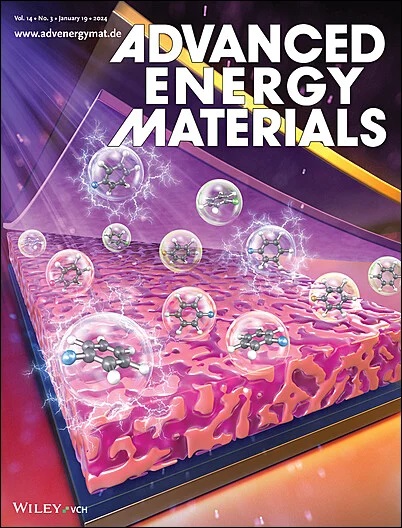Phase Transition in Halide Double Perovskites for Solar-To-Chemical Energy Conversion
IF 24.4
1区 材料科学
Q1 CHEMISTRY, PHYSICAL
引用次数: 0
Abstract
Halide double perovskites have recently garnered significant interest in solar energy conversion applications owing to their non-toxic and high solar absorption properties. However, unanticipated structural distortion within these materials can compromise their performance, suppressing the structural distortion is essential and remains challenging. Here, it is reported that using phenylethylamine triggering the disorder-order phase transition can largely increase the ordering extent of octahedra in double perovskite Cs2AgBiBr6, which can suppress self-trapped exciton and defect and enable rapid charge separation, leading to exceptional photo-physics/chemistry properties with over sixfold photoactivity enhancement in the photocatalytic C−H bond activation compared to less ordered structures. This work provides an effective strategy to solve the challenging problem of the disorder phenomenon of halide double perovskites for boosting solar-to-chemical energy conversion.

用于太阳能-化学能转换的卤化物双钙钛矿相变研究
卤化物双钙钛矿由于其无毒和高太阳能吸收特性,最近在太阳能转换应用中引起了极大的兴趣。然而,这些材料中意想不到的结构扭曲会影响其性能,抑制结构扭曲是必不可少的,并且仍然具有挑战性。本文报道,使用苯基乙胺触发无序-有序相变可以大大提高双钙钛矿Cs2AgBiBr6中八面体的有序程度,从而抑制自捕获激子和缺陷,实现快速电荷分离,从而获得优异的光物理/化学性能,与无序结构相比,光催化C−H键活化的光活性增强了6倍以上。这项工作为解决卤化物双钙钛矿无序现象这一具有挑战性的问题,促进太阳能到化学能的转换提供了有效的策略。
本文章由计算机程序翻译,如有差异,请以英文原文为准。
求助全文
约1分钟内获得全文
求助全文
来源期刊

Advanced Energy Materials
CHEMISTRY, PHYSICAL-ENERGY & FUELS
CiteScore
41.90
自引率
4.00%
发文量
889
审稿时长
1.4 months
期刊介绍:
Established in 2011, Advanced Energy Materials is an international, interdisciplinary, English-language journal that focuses on materials used in energy harvesting, conversion, and storage. It is regarded as a top-quality journal alongside Advanced Materials, Advanced Functional Materials, and Small.
With a 2022 Impact Factor of 27.8, Advanced Energy Materials is considered a prime source for the best energy-related research. The journal covers a wide range of topics in energy-related research, including organic and inorganic photovoltaics, batteries and supercapacitors, fuel cells, hydrogen generation and storage, thermoelectrics, water splitting and photocatalysis, solar fuels and thermosolar power, magnetocalorics, and piezoelectronics.
The readership of Advanced Energy Materials includes materials scientists, chemists, physicists, and engineers in both academia and industry. The journal is indexed in various databases and collections, such as Advanced Technologies & Aerospace Database, FIZ Karlsruhe, INSPEC (IET), Science Citation Index Expanded, Technology Collection, and Web of Science, among others.
 求助内容:
求助内容: 应助结果提醒方式:
应助结果提醒方式:


